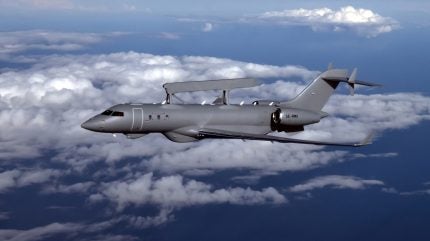
Saab and Korea Aerospace Industries (KAI) have signed a Memorandum of Understanding (MoU) to collaborate on the AEW&C II competition and future domestic defence programmes. This move could shape the future of airborne surveillance in South Korea.
The aerospace defence sectors of South Korea and Sweden are set to strengthen their partnership with a new agreement that aims to transfer technology and build local capabilities.
Signed at the Korea Army International Defense Industry Exhibition (KADEX), the MoU between Saab and KAI focuses on developing and integrating Saab’s GlobalEye AEW&C (Airborne Early Warning & Control) system into Korea’s defence landscape.
A partnership in surveillance
The MoU is a partnership centred on Saab’s GlobalEye. Saab’s bid for South Korea’s AEW&C II competition hinges on the GlobalEye platform.
If selected, the partnership between Saab and KAI will transform Bombardier’s Global 6500 business jet into the GlobalEye AEW&C special mission aircraft. This transformation will involve modifications to the airframe and aerodynamics and system installation, integration, and testing.
Notably, the agreement includes training and technology transfer, enabling KAI to independently carry out future upgrades, modifications, and maintenance of the GlobalEye system within South Korea.
In South Korea’s military fixed-wing sector, AEW&C ranks third in expenditure with an investment of $427.6m over 2024–29, according to GlobalData’s “South Korea Defense Market 2024-2029” report.
South Korea’s current AEW&C aircraft offering is Boeing’s B737, acquiring four between 2011 and 2012.
“This MoU between Saab and KAI will increase critical radar technology competence and create domestic capability and self-sustainability to secure strategic independence for the Republic of Korea in the airborne surveillance segment,” said Markus Borgljung, vice president and deputy head of Business Area Surveillance at Saab. “GlobalEye is the only system that offers real technology transfer.”
Saab has recently delivered its fifth and final aircraft to the United Arab Emirates on 17 September, 2024, following an initial contract in November 2015. Meanwhile, on 27 June, 2024, Saab finalised an agreement with the Swedish Defence Materiel Administration for a third GlobalEye aircraft delivered between 2024 and 2029.
On 19 July, 2024, Saab reported a record order intake of Skr40bn ($3.7bn) for Q2, marking the second-highest quarterly figure in the company’s history and up from Skr14.3bn ($1.3bn) in the same period last year.
Building future special mission aircraft
The partnership extends beyond the AEW&C II competition, with Saab and KAI eyeing future opportunities within the Republic of Korea. According to Chongho Yoon, senior executive vice president and general manager of Aircraft Program Division at KAI, the agreement could serve as a “stepping stone” for further collaboration on domestic and international special mission aircraft programmes.
“Through the technology transfer, we will strengthen our capabilities for future independent domestic research and development for future Special Mission Aircraft programs,” Yoon added.
KAI’s role in this partnership is to lead the modifications, testing, and integration processes for GlobalEye in South Korea.
As Saab and KAI deepen their partnership, the AEW&C II competition represents a juncture for South Korea’s airborne surveillance.




